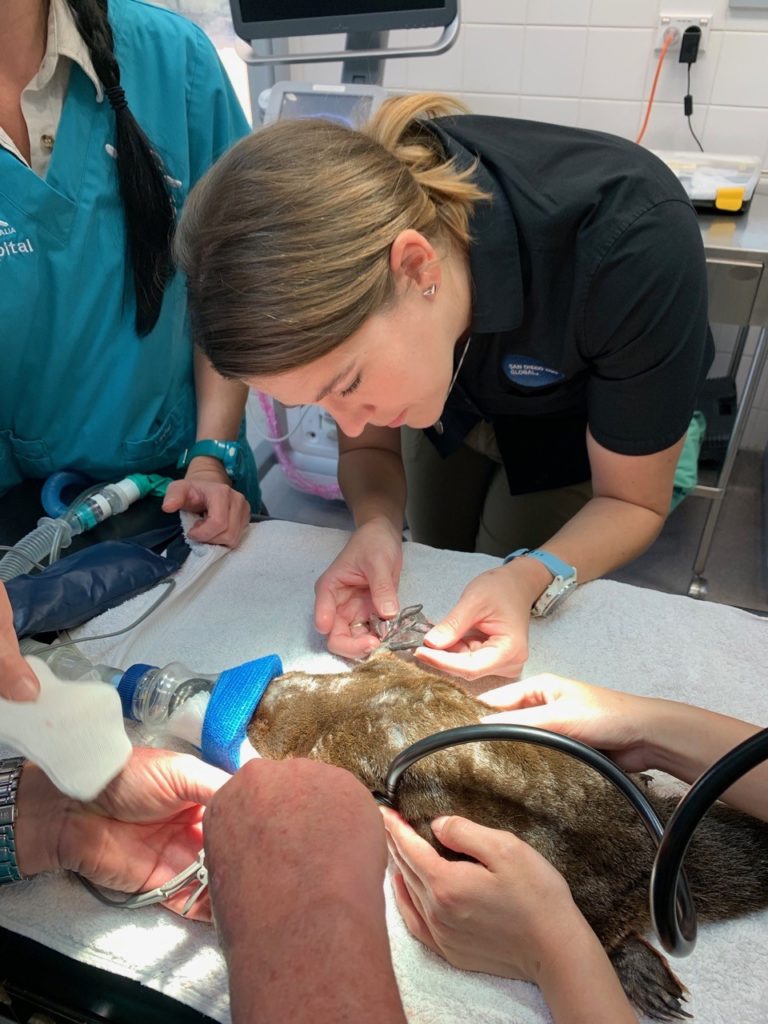
Ten years ago at the Taronga Zoo in Sydney, Australia, I was lucky enough to see my first platypus. I couldn’t have imagined that ten years later I would be part of the team helping to bring them to San Diego for the first time. When the new platypus habitat at the Safari Park’s Walkabout Australia exhibit opened earlier this month, it brought this iconic Australian species to the US for just the third time ever, in a state-of-the-art exhibit that offers the only opportunity to see these enchanting little mammals outside Australia.
Before the platypuses arrived, I spent just over two weeks in Australia, learning from veterinarians and animal care staff at the Taronga Zoo and Healesville Sanctuary. I was one of four staff members who were sent to be trained in the specialized husbandry and veterinary care these animals require. My goal was to absorb as much information as I could from veterinary experts in Australia, who have years of experience caring for these unique mammals.

I met platypuses Eve (a 15-year-old female born at the Taronga Zoo) and Birra (short for Birrarung, an eight-year-old male born at the Healesville Sanctuary), who were destined for the Safari Park. In fact, it was part of our agreement to transfer these animals that I be there during their pre-export veterinary examinations. I was lucky enough to be a part of many procedures on Australian native species, focusing especially on monotremes—the egg-laying mammal group that includes the platypus and echidnas. Every aspect about these animals’ biology and medicine is a bit different from our typical mammals, so it was crucial to see these evolutionary oddities in person.
When the time came for our platypuses to travel from Sydney to San Diego, they were accompanied by experienced platypus husbandry staff who monitored them during and after the transport. After their overseas transport, both have acclimated well to their new environment—as is apparent by the way they’ve been exploring their new habitat and foraging for the live food keepers provide.
One of my favorite platypus facts is that platypuses “see” underwater, using electroreceptors and mechanoreceptors located on their bill. In fact, that’s how they find their small prey. Underwater, their eyes (and ears) actually close in a nice hydrodynamic groove as they swim and forage for food. This adaptation to their aquatic lifestyle underscores the new territory the Safari Park is covering by exhibiting this species. Their aquatic nature is unlike any other animal we have at the Park.
These animals rely on fresh, running water—and cool water at that. So, adequate water quality to provide clean, chilled water is essential. Platypuses are densely furred and cannot readily dissipate heat, so they need to be provided a cool (air conditioned) environment and cool water—chilled to under 67 degrees Fahrenheit! We have special staff who work to maintain their water systems as well as the water systems that maintain their invertebrate prey. Our nutrition department has worked to source appropriate platypus food with a distinctly American flare—called “yabbies” Down Under, the crayfish that our platypuses eat are American in origin. Luckily, our animals have taken to their new food well during their important transition.
I’m thrilled to be able to work with such an amazing, specialized mammal, and I look forward to keeping them healthy and getting to know them even better.
Meredith Clancy is a clinical veterinarian at the San Diego Zoo Safari Park.




